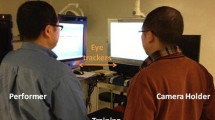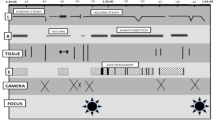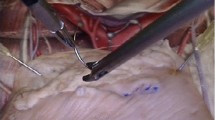Abstract
Background
This video-aided observational study was conducted to examine team cooperation among surgeons in a surgical team built up with different time lengths. We predicted that the surgeons in a team that has longer teamwork experience would perform more anticipatory movements than surgeons in a surgical team that is newly formed.
Methods
Laparoscopic Nissen fundoplication cases were videotaped with both surgical view and the OR view. An anticipatory movement was identified when a surgeon manually provided direct assistance for an upcoming task without a request by other surgeons in the team.
Result
A total of 28 cases of laparoscopic Nissen fundoplication were videotaped and analyzed. Fifteen operations were performed by surgeons collaborating as a team for 10 weeks, in contrast to 13 operations performed by surgeons paired up for less than 5 weeks. Significantly more anticipatory movements were performed by the surgeons in the dedicated team (22 counts) than by those in the developing team (19 counts, p = 0.029). However, the OR time was not significantly different (dedicated team = 111 min, developing team = 115 min, p = 0.611) between the two teams which suggests that other types of coordination would also influence surgical teamwork.
Conclusion
Working in a team allows surgeons to develop sophisticated cognition to anticipate an upcoming task and provide assistance without verbal communication. The greater number of anticipatory movements observed in the dedicated surgical team suggests that anticipatory movement can be a valuable measure for team cooperation. Further research with a larger number of cases is needed to see whether performance of more anticipatory movements does shorten OR time.


Similar content being viewed by others
References
Baker DP, Day R, Salas E (2006) Teamwork as an essential component of high-reliability organizations. Health Serv Res 41:1576–1598
Salas E, Baker D, King H, Battles J (2006) Special section commentary: opportunities and challenges for human factors and ergonomics in enhancing patient safety. Hum Factors 48:1–4
Wilson KA, Salas E, Priest HA, Andrews D (2007) Errors in the heat of battle: taking a closer look at shared cognition breakdowns through teamwork. Hum Factors 49:243–256
Wilson KA, Burke CS, Priest HA, Salas E (2005) Promoting health care safety through training high reliability teams. Qual Saf Health Care 14:303–309
Chopra V, Bovill JG, Spierdijk J, Koornneef F (1992) Reported significant observations during anaesthesia: a prospective analysis over an 18-month period. Br J Anaesth 68:13–17
Donchin Y, Gopher D, Olin M, Badihi Y, Biesky M, Sprung CL, Pizov R, Cotev S (2003) A look into the nature and causes of human errors in the intensive care unit. 1995. Qual Saf Health Care 12:143–147 discussion 147-148
Gawande AA, Thomas EJ, Zinner MJ, Brennan TA (1999) The incidence and nature of surgical adverse events in Colorado and Utah in 1992. Surgery 126:66–75
Carron AV, Eys MA, Burke SM, Jowette S, Lavallee D (2007) Team cohesion: nature, correlates, and development. In: Jowett S, Lavallee D (eds) Social psychology in sport. Human Kinetics, Champaign, IL, pp 91–116
Entin EE, Serfaty D (1999) Adaptive team coordination. Hum Factors 41:312–325
Espinosa A, Lerch J, Kraut R (2004) Explicit versus implicit coordination mechanisms and task dependencies: one size does not fit all. In: Salas E, Fiore SM (eds) Team cognition: process and performance at the inter- and intra-individual level. APA, Washington, DC, pp 107–129
Zheng B, Taylor MD, Swanström LL (2008) An observational study of surgery-related activities between nurses and surgeons during laparoscopic surgery. Am J Surg, Epub ahead of print 6 September 2008. doi:10.1016/j.amjsurg.2008.01.034
de Leval MR, Carthey J, Wright DJ, Farewell VT, Reason JT (2000) Human factors and cardiac surgery: a multicenter study. J Thorac Cardiovasc Surg 119:661–672
Carthey J (2003) The role of structured observational research in health care. Qual Saf Health Care 12(Suppl 2):ii13–ii16
Dixon-Woods M (2003) What can ethnography do for quality and safety in health care? Qual Saf Health Care 12:326–327
Savage J (2000) Ethnography and health care. BMJ 321:1400–1402
Mackenzie CF, Hu FM, Xiao Y, Seagull FJ (2003) Video acquisition and audio system network (VAASNET) for analysis of workplace safety performance. Biomed Instrum Technol 37:285–291
Acknowledgments
This project was supported by Legacy Research Advisor Committee Grant 2006. The authors thank the surgeons, OR nurses, and anesthesiologists at Legacy Portland Hospital for their cooperation and contributions.
Author information
Authors and Affiliations
Corresponding author
Rights and permissions
About this article
Cite this article
Zheng, B., Swanström, L.L. Video analysis of anticipatory movements performed by surgeons during laparoscopic procedures. Surg Endosc 23, 1494–1498 (2009). https://doi.org/10.1007/s00464-009-0386-6
Received:
Accepted:
Published:
Issue Date:
DOI: https://doi.org/10.1007/s00464-009-0386-6




